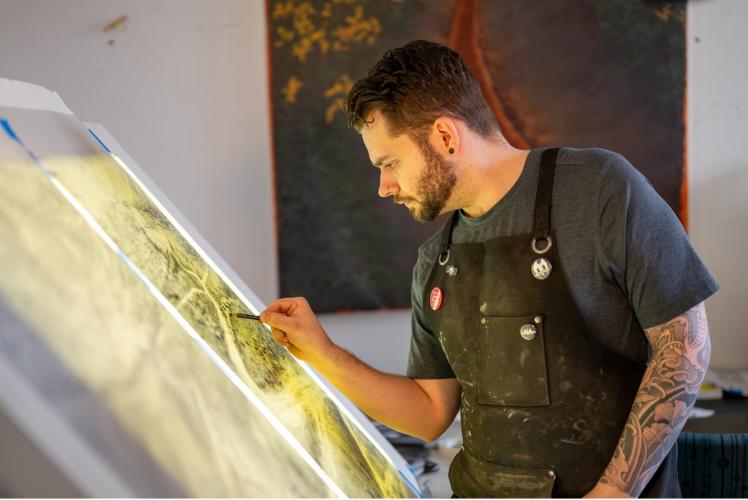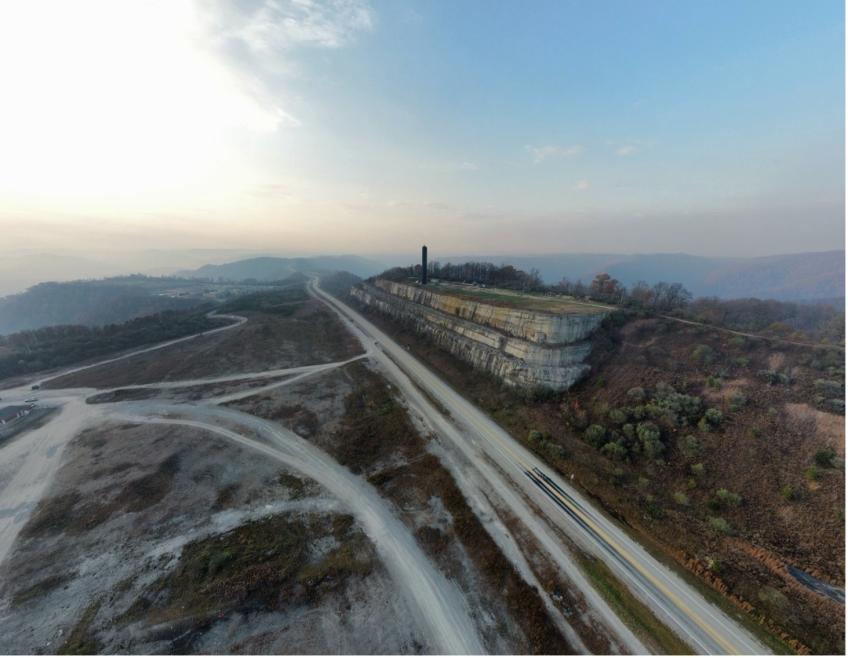

Designed to support students in the creation of projects, ideas and research that they otherwise may not have been able pursue due to financial constraints, the Hollis Parry/Ann Billman Fine Arts Award is a scholarship for full-time graduate students in the College of Fine Arts. Students from any of the college's schools can apply, with awards ranging from $1,000-$5,000.
The winner of the 2023 Hollis Parry/ Ann Billman Fine Arts Award was graduate student Tyler Thenikl, who won for his project proposal “Vanishing Points,” an immersive art exhibition that showcases the harmful effects of mountaintop removal mining across Appalachia. By showcasing the landscapes through his art, Thenikl hopes to raise awareness and encourage dialogue about the consequences of the extraction techniques.
Q:Tell us about your background/undergraduate experience.
A:I went to what is now at the University of Olivet, formerly Olivet college. That is in Olivet, Michigan, it's south of Lansing, a very, very small liberal arts school. And there I got a bachelor's degree in graphic design and studio art. And now I'm in my third year here, I'm in grad school at OU. Studying printmaking in the School of Art Design.
Q:Can you describe your creative work?
A:When I was working on my undergraduate degree, I took my first printmaking classes, and that's kind of my specialty now. I think of myself as an artist first and then a printmaker second, because I explore a lot of different media… But the printmaking was a core source of inspiration for me. There was something about the processes that are involved, and the tedious nature where you kind of have to work and collaborate with the different materials you use to make what you want. And that was kind of inspiring to me. I started to feel like I had some kind of relationship with those materials, and I needed to respect them. I do a lot of different stuff. It's technical, it's a lot more intuitive. As part of this project, I've been able to explore it all and travel and meet a lot of people. It's been fantastic.
Q:Where do you find inspiration for your art?
A:I think for me this always goes back to nature, I find that I'm deeply inspired by it. I grew up in Michigan, in the suburbs in Grand Rapids, but I was also very much outdoors. And I think it instilled this sense of wonderment and reverence for the outdoors and natural spaces that really propels my work now.
When I was in undergrad, and started focusing on studying art, I would always gravitate towards these landscape paintings, these big, grandiose, beautiful images that were in museums and stuff. They were great, but they don't include all the environmental issues that we have. They celebrate this untouched, beautiful, grandiose nature, which is always fantastic. But I felt that as an artist, as a contemporary artist, and as a contemporary landscape artist, I needed to address some of those gaps, some of those silences in this very long, overarching narrative.
So now what I do is focus on landscapes that are marred by some kind of distress, whether it's from industry or pollution, destruction, or some kind of injustice. And that's where I got into researching mining around us, and then also down south and [in] West Virginia and eastern Kentucky.
Q:What was it about mountaintop removal that inspired your work?
A:I was inspired by local nonprofits like Rural Action
, and specifically some of the work that John Sabraw
has been doing with them to clean up the watersheds and also produce paint that helps propel his art practice. I got to work with him. And I volunteered with Rural Action a little bit and have learned a lot about the area and this legacy pollution with this acid mine drainage. But I also knew about mountaintop removal just across the river. I felt that for me personally, as I'm starting this very large body of work, that I wanted to work on something that was still ongoing, or maybe a little bit more pressing.
I felt that mountaintop removal, for me, was just a little bit bigger, and I kind of created a space of my own in this region. And then I also felt like a landscape, these vast, wide, sweeping areas that I'm looking at reminded me in a strange, kind of ironic way of some of those old landscape paintings. They have the same point of view, or it's like very high up, and then you just see so far, all the way to the vanishing point of the image where things are disappearing in the atmosphere of the sky. And so for me, I'm always trying to reference those just a little bit.
Q:How has the Billman Scholarship enhanced your graduate experience in the College of Fine Arts?
A:It's like night and day, it has helped so much. Honestly, I've gotten used to just working with very few resources, a small amount of time and very small budgets. And I knew that to pursue the grandiose project that I had proposed, I was thinking pretty big. And then I would need help, I would need funding and I would need equipment. And frankly, if I had not gotten the award, I don't think I would have been able to do what I'm doing now. It's been so critical to this project.
This allows me to get these vantage points that I want to look at and actually be able to begin to understand and convey them—the expanses of these places I want to talk about. Even my drone flights that will be 10 minutes long, will capture maybe a mile of distance or something. These things are happening [in a] really big way. And, again, though, the financial resources not only allowed me to get the equipment, but it also allowed me to have some security and get those materials, so I don't have to keep working and, you know, flipping burgers on the side while I'm trying to finish this stuff up.
Q:How do you think scholarships like the Billman Awards make a difference to the arts?
A:Art programs are historically underfunded, they tend to be the last thing that gets funded, or it [often] feels like it. It's such a fabulous resource to have, that we can nominate certain students to be able to work further and realize their dreams. I've transformed and kind of leveled up in the last year of the work I'm able to do as part of the scholarship. Even the opportunity of applying and getting to talk with more people within the colleges on the selection committees was great. So many of these big projects that have been publicized and brought attention to the University and enhanced the community have come from the arts, and without that little bit of funding, they wouldn't happen. I think we would not be in as good of a place as we are.

